Yinhe Han
ODMA: On-Demand Memory Allocation Framework for LLM Serving on LPDDR-Class Accelerators
Dec 10, 2025Abstract:Serving large language models (LLMs) on accelerators with poor random-access bandwidth (e.g., LPDDR5-based) is limited by current memory managers. Static pre-allocation wastes memory, while fine-grained paging (e.g., PagedAttention) is ill-suited due to high random-access costs. Existing HBM-centric solutions do not exploit the characteristics of random-access-constrained memory (RACM) accelerators like Cambricon MLU370. We present ODMA, an on-demand memory allocation framework for RACM. ODMA addresses distribution drift and heavy-tailed requests by coupling a lightweight length predictor with dynamic bucket partitioning and a large-bucket safeguard. Boundaries are periodically updated from live traces to maximize utilization. On Alpaca and Google-NQ, ODMA improves prediction accuracy of prior work significantly (e.g., from 82.68% to 93.36%). Serving DeepSeek-R1-Distill-Qwen-7B on Cambricon MLU370-X4, ODMA raises memory utilization from 55.05% to 72.45% and improves RPS and TPS by 29% and 27% over static baselines. This demonstrates that hardware-aware allocation unlocks efficient LLM serving on RACM platforms.
ANNIE: Be Careful of Your Robots
Sep 03, 2025Abstract:The integration of vision-language-action (VLA) models into embodied AI (EAI) robots is rapidly advancing their ability to perform complex, long-horizon tasks in humancentric environments. However, EAI systems introduce critical security risks: a compromised VLA model can directly translate adversarial perturbations on sensory input into unsafe physical actions. Traditional safety definitions and methodologies from the machine learning community are no longer sufficient. EAI systems raise new questions, such as what constitutes safety, how to measure it, and how to design effective attack and defense mechanisms in physically grounded, interactive settings. In this work, we present the first systematic study of adversarial safety attacks on embodied AI systems, grounded in ISO standards for human-robot interactions. We (1) formalize a principled taxonomy of safety violations (critical, dangerous, risky) based on physical constraints such as separation distance, velocity, and collision boundaries; (2) introduce ANNIEBench, a benchmark of nine safety-critical scenarios with 2,400 video-action sequences for evaluating embodied safety; and (3) ANNIE-Attack, a task-aware adversarial framework with an attack leader model that decomposes long-horizon goals into frame-level perturbations. Our evaluation across representative EAI models shows attack success rates exceeding 50% across all safety categories. We further demonstrate sparse and adaptive attack strategies and validate the real-world impact through physical robot experiments. These results expose a previously underexplored but highly consequential attack surface in embodied AI systems, highlighting the urgent need for security-driven defenses in the physical AI era. Code is available at https://github.com/RLCLab/Annie.
KAITIAN: A Unified Communication Framework for Enabling Efficient Collaboration Across Heterogeneous Accelerators in Embodied AI Systems
May 15, 2025Abstract:Embodied Artificial Intelligence (AI) systems, such as autonomous robots and intelligent vehicles, are increasingly reliant on diverse heterogeneous accelerators (e.g., GPGPUs, NPUs, FPGAs) to meet stringent real-time processing and energy-efficiency demands. However, the proliferation of vendor-specific proprietary communication libraries creates significant interoperability barriers, hindering seamless collaboration between different accelerator types and leading to suboptimal resource utilization and performance bottlenecks in distributed AI workloads. This paper introduces KAITIAN, a novel distributed communication framework designed to bridge this gap. KAITIAN provides a unified abstraction layer that intelligently integrates vendor-optimized communication libraries for intra-group efficiency with general-purpose communication protocols for inter-group interoperability. Crucially, it incorporates a load-adaptive scheduling mechanism that dynamically balances computational tasks across heterogeneous devices based on their real-time performance characteristics. Implemented as an extension to PyTorch and rigorously evaluated on a testbed featuring NVIDIA GPUs and Cambricon MLUs, KAITIAN demonstrates significant improvements in resource utilization and scalability for distributed training tasks. Experimental results show that KAITIAN can accelerate training time by up to 42% compared to baseline homogeneous systems, while incurring minimal communication overhead (2.8--4.3%) and maintaining model accuracy. KAITIAN paves the way for more flexible and powerful heterogeneous computing in complex embodied AI applications.
RTLMarker: Protecting LLM-Generated RTL Copyright via a Hardware Watermarking Framework
Jan 05, 2025



Abstract:Recent advances of large language models in the field of Verilog generation have raised several ethical and security concerns, such as code copyright protection and dissemination of malicious code. Researchers have employed watermarking techniques to identify codes generated by large language models. However, the existing watermarking works fail to protect RTL code copyright due to the significant syntactic and semantic differences between RTL code and software code in languages such as Python. This paper proposes a hardware watermarking framework RTLMarker that embeds watermarks into RTL code and deeper into the synthesized netlist. We propose a set of rule-based Verilog code transformations , ensuring the watermarked RTL code's syntactic and semantic correctness. In addition, we consider an inherent tradeoff between watermark transparency and watermark effectiveness and jointly optimize them. The results demonstrate RTLMarker's superiority over the baseline in RTL code watermarking.
DaDu-E: Rethinking the Role of Large Language Model in Robotic Computing Pipeline
Dec 02, 2024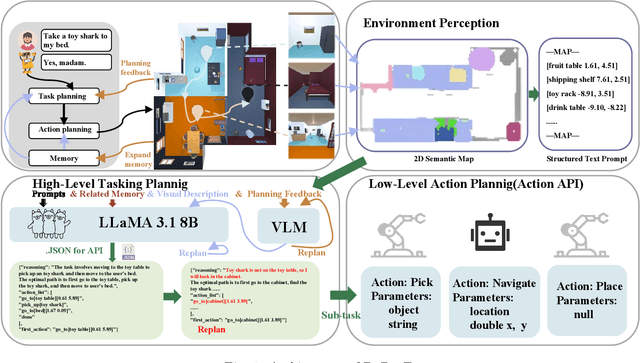

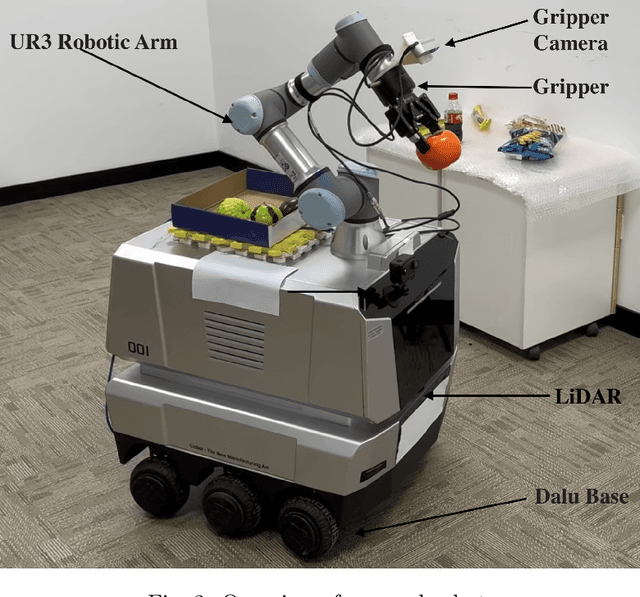
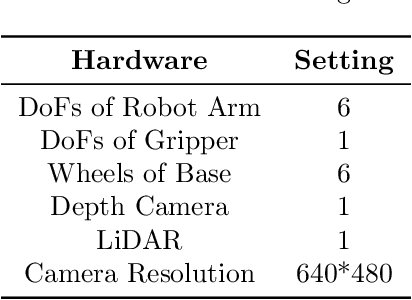
Abstract:Performing complex tasks in open environments remains challenging for robots, even when using large language models (LLMs) as the core planner. Many LLM-based planners are inefficient due to their large number of parameters and prone to inaccuracies because they operate in open-loop systems. We think the reason is that only applying LLMs as planners is insufficient. In this work, we propose DaDu-E, a robust closed-loop planning framework for embodied AI robots. Specifically, DaDu-E is equipped with a relatively lightweight LLM, a set of encapsulated robot skill instructions, a robust feedback system, and memory augmentation. Together, these components enable DaDu-E to (i) actively perceive and adapt to dynamic environments, (ii) optimize computational costs while maintaining high performance, and (iii) recover from execution failures using its memory and feedback mechanisms. Extensive experiments on real-world and simulated tasks show that DaDu-E achieves task success rates comparable to embodied AI robots with larger models as planners like COME-Robot, while reducing computational requirements by $6.6 \times$. Users are encouraged to explore our system at: \url{https://rlc-lab.github.io/dadu-e/}.
COMET: Towards Partical W4A4KV4 LLMs Serving
Oct 16, 2024



Abstract:Quantization is a widely-used compression technology to reduce the overhead of serving large language models (LLMs) on terminal devices and in cloud data centers. However, prevalent quantization methods, such as 8-bit weight-activation or 4-bit weight-only quantization, achieve limited performance improvements due to poor support for low-precision (e.g., 4-bit) activation. This work, for the first time, realizes practical W4A4KV4 serving for LLMs, fully utilizing the INT4 tensor cores on modern GPUs and reducing the memory bottleneck caused by the KV cache. Specifically, we propose a novel fine-grained mixed-precision quantization algorithm (FMPQ) that compresses most activations into 4-bit with negligible accuracy loss. To support mixed-precision matrix multiplication for W4A4 and W4A8, we develop a highly optimized W4Ax kernel. Our approach introduces a novel mixed-precision data layout to facilitate access and fast dequantization for activation and weight tensors, utilizing the GPU's software pipeline to hide the overhead of data loading and conversion. Additionally, we propose fine-grained streaming multiprocessor (SM) scheduling to achieve load balance across different SMs. We integrate the optimized W4Ax kernel into our inference framework, COMET, and provide efficient management to support popular LLMs such as LLaMA-3-70B. Extensive evaluations demonstrate that, when running LLaMA family models on a single A100-80G-SMX4, COMET achieves a kernel-level speedup of \textbf{$2.88\times$} over cuBLAS and a \textbf{$2.02 \times$} throughput improvement compared to TensorRT-LLM from an end-to-end framework perspective.
BitQ: Tailoring Block Floating Point Precision for Improved DNN Efficiency on Resource-Constrained Devices
Sep 25, 2024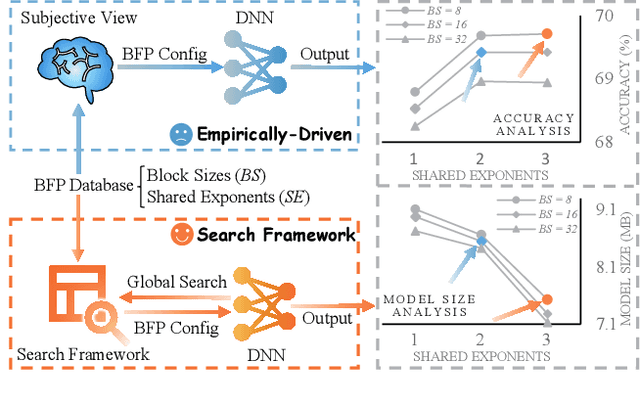
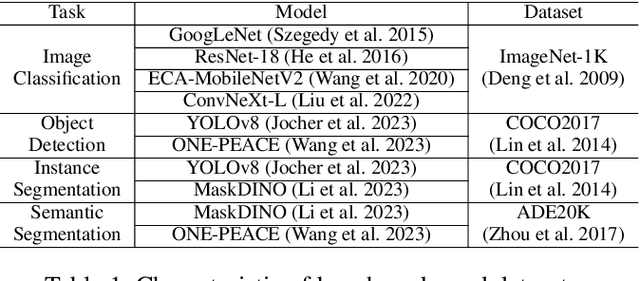
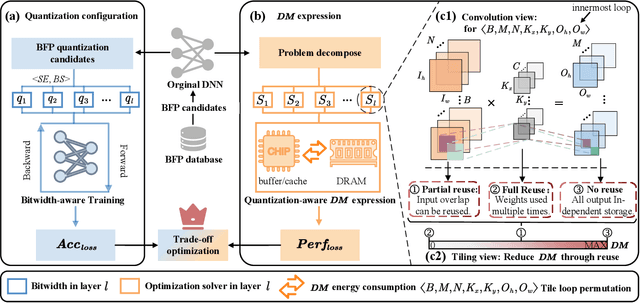

Abstract:Deep neural networks (DNNs) are powerful for cognitive tasks such as image classification, object detection, and scene segmentation. One drawback however is the significant high computational complexity and memory consumption, which makes them unfeasible to run real-time on embedded platforms because of the limited hardware resources. Block floating point (BFP) quantization is one of the representative compression approaches for reducing the memory and computational burden owing to their capability to effectively capture the broad data distribution of DNN models. Unfortunately, prior works on BFP-based quantization empirically choose the block size and the precision that preserve accuracy. In this paper, we develop a BFP-based bitwidth-aware analytical modeling framework (called ``BitQ'') for the best BFP implementation of DNN inference on embedded platforms. We formulate and resolve an optimization problem to identify the optimal BFP block size and bitwidth distribution by the trade-off of both accuracy and performance loss. Experimental results show that compared with an equal bitwidth setting, the BFP DNNs with optimized bitwidth allocation provide efficient computation, preserving accuracy on famous benchmarks. The source code and data are available at https://github.com/Cheliosoops/BitQ.
SuperEncoder: Towards Universal Neural Approximate Quantum State Preparation
Aug 10, 2024Abstract:Numerous quantum algorithms operate under the assumption that classical data has already been converted into quantum states, a process termed Quantum State Preparation (QSP). However, achieving precise QSP requires a circuit depth that scales exponentially with the number of qubits, making it a substantial obstacle in harnessing quantum advantage. Recent research suggests using a Parameterized Quantum Circuit (PQC) to approximate a target state, offering a more scalable solution with reduced circuit depth compared to precise QSP. Despite this, the need for iterative updates of circuit parameters results in a lengthy runtime, limiting its practical application. In this work, we demonstrate that it is possible to leverage a pre-trained neural network to directly generate the QSP circuit for arbitrary quantum state, thereby eliminating the significant overhead of online iterations. Our study makes a steady step towards a universal neural designer for approximate QSP.
Natural language is not enough: Benchmarking multi-modal generative AI for Verilog generation
Jul 11, 2024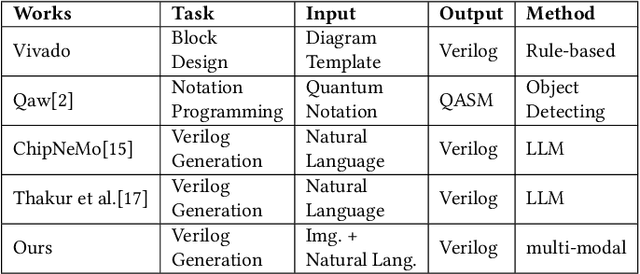
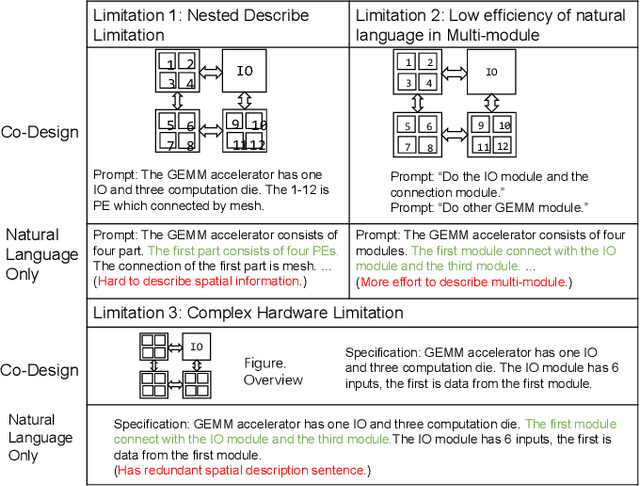
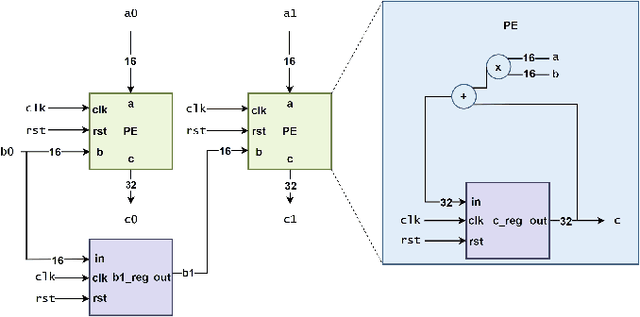
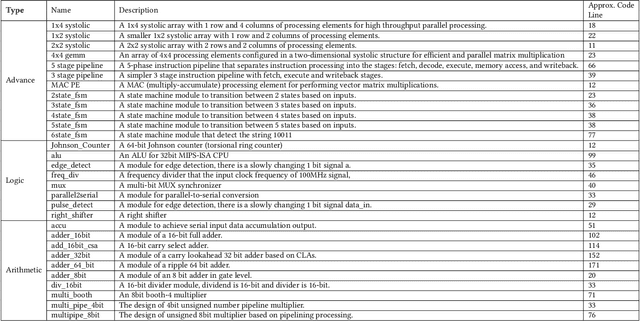
Abstract:Natural language interfaces have exhibited considerable potential in the automation of Verilog generation derived from high-level specifications through the utilization of large language models, garnering significant attention. Nevertheless, this paper elucidates that visual representations contribute essential contextual information critical to design intent for hardware architectures possessing spatial complexity, potentially surpassing the efficacy of natural-language-only inputs. Expanding upon this premise, our paper introduces an open-source benchmark for multi-modal generative models tailored for Verilog synthesis from visual-linguistic inputs, addressing both singular and complex modules. Additionally, we introduce an open-source visual and natural language Verilog query language framework to facilitate efficient and user-friendly multi-modal queries. To evaluate the performance of the proposed multi-modal hardware generative AI in Verilog generation tasks, we compare it with a popular method that relies solely on natural language. Our results demonstrate a significant accuracy improvement in the multi-modal generated Verilog compared to queries based solely on natural language. We hope to reveal a new approach to hardware design in the large-hardware-design-model era, thereby fostering a more diversified and productive approach to hardware design.
Corki: Enabling Real-time Embodied AI Robots via Algorithm-Architecture Co-Design
Jul 05, 2024



Abstract:Embodied AI robots have the potential to fundamentally improve the way human beings live and manufacture. Continued progress in the burgeoning field of using large language models to control robots depends critically on an efficient computing substrate. In particular, today's computing systems for embodied AI robots are designed purely based on the interest of algorithm developers, where robot actions are divided into a discrete frame-basis. Such an execution pipeline creates high latency and energy consumption. This paper proposes Corki, an algorithm-architecture co-design framework for real-time embodied AI robot control. Our idea is to decouple LLM inference, robotic control and data communication in the embodied AI robots compute pipeline. Instead of predicting action for one single frame, Corki predicts the trajectory for the near future to reduce the frequency of LLM inference. The algorithm is coupled with a hardware that accelerates transforming trajectory into actual torque signals used to control robots and an execution pipeline that parallels data communication with computation. Corki largely reduces LLM inference frequency by up to 8.0x, resulting in up to 3.6x speed up. The success rate improvement can be up to 17.3%. Code is provided for re-implementation. https://github.com/hyy0613/Corki
 Add to Chrome
Add to Chrome Add to Firefox
Add to Firefox Add to Edge
Add to Edge